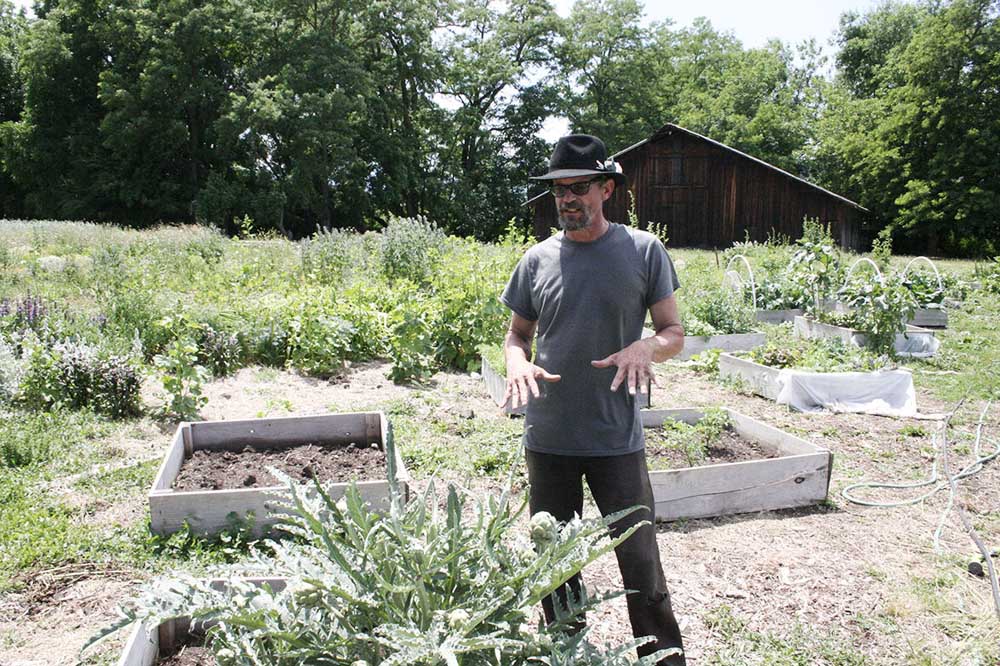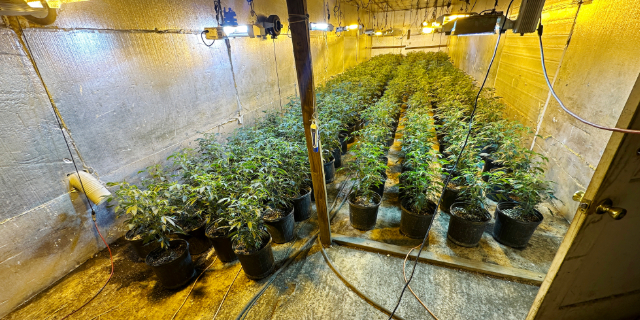Hanley Farm preserves history, feeds Southern Oregon families
Published 12:30 pm Sunday, June 18, 2023

- Doug Lofdahl, farm and food program manager for the Family Nurturing Center nonprofit, explains how activities at Hanley Farm help families disrupted by substance abuse and criminal justice problems.
Time stands still at Hanley Farm, situated on 37 acres between Central Point and Jacksonville.
Trending
The house and outbuildings where the Hanley family once lived now bear witness to the region’s history, as do the heirlooms and old farm implements they accumulated over more than a century.
Biggest artifact
“Hanley Farm is what we consider the biggest artifact in our collections,” said Anna Sloan, curator of the Southern Oregon Historical Society, the property’s owner.
Though it’s rich in history, the farm continues to serve its original purpose: growing food.
Keeping an active agriculture operation on the property is critical to the society’s goal of maintaining its integrity and honoring its previous owners.
Farming continues
“Having agriculture part of what’s happening there feels very authentic,” Sloan said. “It was important for the family to have that usage be part of the legacy of the property.”
Of course, the land’s cultivation looks different today than when it was operated by the Hanley family, but the change has been a constant at the property.
Even before the area was settled by Europeans and their descendants, Native Americans gathered acorns there and processed them into flour.
The stone mortar and pestles were buried when not in use, eventually becoming invaluable archeological objects.
“People have been producing plant-based products from that property for thousands of years,” Sloan said.
Transported in time
The current farm was once part of a larger 640-acre property purchased by Michael Hanley in 1857 for $6,000 in gold, which he earned by supplying beef to miners.
Agriculture in the isolated Rogue Valley was largely subsistence-based in those early years but took on new iterations as machinery and transportation advanced.
The farm evolved as it was divided among family members, with the original homestead was eventually donated to the Southern Oregon Historical Society four decades ago.
“It’s an amazing example of being transported in time,” Sloan said.
The house has remained largely unchanged and is preserved as a museum, with the historical society limiting public access to special events.
“Everything in the walls, we decided to treat as a historical treasure,” Sloan said. “It gives us a really complete picture in ways other properties that don’t have that time-depth aren’t able to provide. You get pieces of the story that come from every era.”
Feeding families
Nowadays, the farm’s cultivated acres are dedicated to fruits and vegetables that are provided to area families that are reconciling after suffering through addiction and legal troubles.
The property’s agricultural legacy is carried on by the Family Nurturing Center, which has found that it serves both practical and psychological purposes for clients.
“Feeding people — that’s the history of the farm. All farms throughout history, their purpose is to feed people,” said Doug Lofdahl, the center’s farm and food program manager.
Crop and livestock production wasn’t initially among the services offered by the organization, which was founded in 2005.
While helping children and parents, the nonprofit found that their higher-level functioning was hindered when basic needs went unmet.
“One of them that was really prevalent was families not having enough food to eat,” Lofdahl said.
Cooking lessons
The nonprofit began teaching parents how to stretch a buck by cooking meals from scratch and improve nutrition by incorporating more produce in their diets.
The approach is aligned with the organization’s broader intent to look beyond the immediate needs of clients and offer them long-term solutions.
“It’s hard work but it’s very rewarding,” Lofdahl said.
A mutual acquaintance introduced the Family Nurturing Center to Hanley Farm a decade ago, sparking the idea of offering classes about growing food in addition to cooking it.
“They have a certain pride in it: ‘That’s our farm,’” Lofdahl said. “If someone grew something, they are going to eat that vegetable, 100% guaranteed. That’s a huge connection.”
The farm setting offered some respite for Crystal Pitts and her husband, who were enrolled in residential drug and alcohol treatment about seven years ago.
They’d never really learned to be parents, which began to change as they spent time with their kids in the countryside, she said.
“It was another opportunity for us to have family time together,” Pitts said. “It really helped us learn how to engage with our children.”
Mentoring parents
These days, she’s employed as a parent mentor at the Family Nurturing Center and her family continues to share meals together, as they did during those early farm outings.
“That’s something we still do in our household today, no matter how busy it gets,” Pitts said.
When the COVID pandemic curtailed social interactions, the nonprofit shifted toward having dedicated staff at Hanley Farm grow the produce, which is then distributed to families.
The fruits and vegetables are paired with staples, such as beans, rice, oats and pasta, in a “grocery store” environment, where parents and kids can pick items they’d like to eat.
“We find it helps to have samples and have stuff curated on the shelves oriented toward meals, rather than just a bunch of food on the shelf,” Lofdahl said. “It’s also less stigmatizing to come in and be shopping for food rather than someone giving them a box.”
The organization now leases about 5 acres for crops and 20 acres for livestock, which are no longer slaughtered for meat but still serve a valuable role.
Children naturally become calmer around the animals and less prone to misbehavior to avoid frightening them, Lofdahl said. “It’s a great way to teach kids self-regulation.”
Now that pandemic restrictions have subsided, the organization is planning to again offer more on-the-ground activities at the farm.
Reconnecting
Reconnecting with nature and the outdoors is restorative for participating families, many of whom are otherwise confined to apartment buildings and more urban environments.
“Just being in a setting like this is therapeutic,” Lofdahl said. “When people feel good, they do better. That’s just a human trait.”
Several employees from Family Nurturing Center do the farm work by hand and with a walk-behind tractor, which has several implements.
The organization aims to build healthy soils by rotating crops, which also meets the objective of growing nearly everything normally found in a grocery store’s produce aisle.
In some ways, the simplicity and self-sufficiency of the operation are reminiscent of the farm’s roots in subsistence agriculture.
Focus on food
“We’re focused on providing food, not making money,” Lofdahl said. “We don’t have the market pressure that we have to sell X pounds of anything.”
The nonprofit’s connection to Hanley Farm will hopefully inspire its clients to try their hand at growing food, even if it’s in a small raised bed at an apartment complex, he said.
Raising food can have a wholesome influence on family life, as Lofdahl learned from his father’s stories of growing up on a farm battered by the Dust Bowl and the Depression.
Despite the hardships they suffered, or perhaps because of them, the family remained tight-knit with a positive outlook on life, he said.
“I knew there was something from that experience that could really help families,” Lofdahl said.
Hanley family
No family is immune to conflict, however, and the Hanleys were no exception.
Luckily for historians, they weren’t inclined to throw away letters, diaries and other records, so the disputes and reconciliations among family members aren’t shrouded in mystery.
“The Hanleys never threw anything away, so we have every Christmas card they ever got,” said Alice Mullaly, a longtime volunteer with the Southern Oregon Historical Society.
The documentation is a gold mine for historical research, as the written recollections are paired with photos and physical objects on the property, said Sloan, the society’s curator.
“You see one family’s evolution over generations,” she said. “You get a chance to know people, too. It really fleshes out the people who lived in that space.”
After buying the farm, Michael Hanley and his wife, Martha, produced crops and livestock to feed themselves and their nine children while raising and selling mules as their main “cash crop.”
At that time, mules were commonly used to pull wagons and farm machinery without requiring as much high-quality feed as horses, Mullaly said. “They were powerful animals that were easy to keep.”
Over time, railroads and roads eased travel between the remote valley and more distant markets. The Hanleys continued raising livestock at a separate ranch while wheat and hay were grown at the homestead. Later generations would diversify into grass seed and orchards as well.
“The rich soil is really capable of handling many different types of crops,” Mullaly said.
When the family’s patriarch died, it took 16 years to resolve the estate due to squabbling among the six children who survived to adulthood, she said. Siblings banded together against other siblings, with those alliances breaking up and recombining with new configurations over time.
Ultimately the original homestead was divided into separate plots for each of five children, while the sixth inherited the separate ranch property.
A parcel including the family’s home, outbuildings and more than 100 acres went to Alice Hanley, who never married and farmed the property by herself.
She also single-handedly raised an orphaned niece, Claire, who took over the property after Alice’s death.
Claire managed the farm with two sisters, Martha and Mary, who’d been raised by other family members. None of them ever married — somewhat ironic, considering the property’s current prominence as a nuptial destination.
“It’s a very popular for weddings today,” Mullaly said.
Mary Hanley ended up the last of the line to own the homestead founded by her grandparents, but with no progeny of her own, she had to preserve its agricultural legacy another way.
OSU research center
The bulk of the land she inherited was sold to Jackson County and now serves as Oregon State University’s Southern Oregon Research and Extension Center, while the remaining 37 acres with the homestead were donated to the historical society.
“You could just feel the town encroaching and she wanted people to remember what the farm was like,” Mullaly said. “This is a wonderful way to look at the valley as it’s progressed over the past century and a half.”









